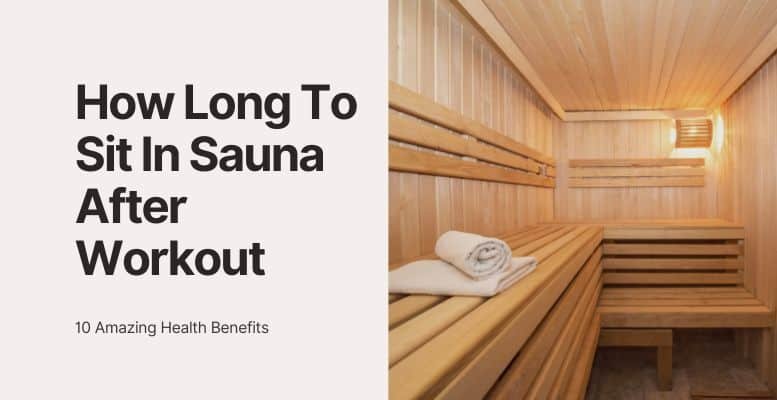Yesterday I had a friend ask me how long to sit in sauna after workout. He read sitting in the sauna can help with dementia and said his family has a history of it. This was my motivation to write this article because, yes, it really can help!
Saunas have been used for centuries all around the world. The heat from the sauna can help you relieve muscle tension and pain. It can also help improve your circulation and cardiovascular health. Sauna use has even been linked with a lower risk of dementia and Alzheimer’s disease. If you’re looking for health benefits from sitting in the sauna, here’s how long you should stay in.
HOW LONG SHOULD YOU STAY IN A SAUNA AFTER A WORKOUT
The length of time you should stay in the sauna depends on a few factors. If you have any medical conditions, talk to your doctor before using one. They can give you specific recommendations based on your health. Generally, most people can stay in it for up to 30 minutes at a time.
If you’re new to using a sauna, start with just 5 or 10 minutes. See how you respond to the heat before increasing the amount of time you spend in there. And be sure to drink plenty of fluids, especially water, both before and after your session. Staying hydrated will help you sweat and prevent you from becoming dehydrated while in the sauna.
10 BENEFITS OF USING A SAUNA AFTER A WORKOUT
You just completed an intense workout, and you’re feeling good. Your muscles are pumped. Your endorphins are flowing. Although I think there is One more thing you should do before you call it a day: spend some time in the sauna. Sitting in one sauna after a workout has many benefits you may not be aware of.
Let’s take a look at a few of them.
Relief from muscular aches and pains
Saunas have been used for centuries as a way to relax and relieve pain. The heat can help loosen tight muscles, increase blood flow, and reduce inflammation. This can all help to provide relief from aches and pains. In addition, saunas can help improve your circulation, further reducing pain and stiffness. If you suffer from chronic pain or muscle soreness, using a sauna regularly can be a great way to find relief.
Improved circulation
Saunas are a great way to improve circulation. When you use a sauna, the heat causes your blood vessels to dilate, which increases flow and helps the body to release toxins. The increased flow also helps to reduce stiffness and pain. In addition, saunas can help to reduce stress levels and promote relaxation. As a result, they offer a wide range of benefits, including improved circulation.
Reduced stress levels
When you hit the sauna, your body temperature rises, and you start to sweat. This process can help release endorphins, hormones that have mood-boosting effects. This will start to create a feeling of relaxation.

Clearer skin
Saunas have been used for centuries to improve overall health and well-being. Saunas can also help improve the appearance of the skin. The high heat of saunas can help to open pores, remove impurities, and promote detoxification. Furthermore, saunas can help improve circulation and increase sweating, which can help flush out toxins and promote the healing of skin blemishes. Regular use can help to give you clearer, healthier skin.
Weight loss
It can also help you lose weight by increasing your metabolic rate. Improved circulation, increased heart rate, and increased sweating. These benefits contribute to improved metabolism, which can lead to weight loss. In addition, saunas can help to reduce water retention and cellulite.
Increased cardiovascular fitness
One of the cardiovascular benefits is when you sit in a sauna raises your heart rate. This increase in heart rate can positively affect your blood pressure, cholesterol levels, and overall heart health.
A Sauna can help reduce inflammation
Inflammation is your natural response to injury or some type of infection, but chronic inflammation can lead to serious problems. The sauna can help reduce inflammation by dilating blood vessels and increasing flow. The increased flow helps remove toxins and waste products from the body, reducing inflammation. The sauna is also thought to help boost the immune system, making the body better fight off infection and disease.
Using a sauna can promote better sleep
Using a sauna has been shown to improve the quality of sleep. In one study, people who used a sauna for 30 minutes before bed for a month reported sleeping better overall and feeling more rested in the morning.
Using a sauna relaxes the body and mind, which can help to prepare for sleep. The sauna’s heat also raises your temperature, mimicking the natural decrease in body temperature at night. This drop in temperature is thought to be one of the cues that tells you it is time to sleep.
In addition, using a sauna has been shown to reduce stress levels. Stress can interfere with sleep by preventing the body from relaxing and causing racing thoughts. Reducing stress may help to improve sleep quality. It is a simple way to relax the mind and body and promote better sleep.
Saunas can relieve tension headaches
Tension headaches and horrible if you have had one. Usually, they are caused by muscle tension in the shoulders or neck. The heat of the sauna helps to relax muscles and improve blood circulation. As a result, many people find their headaches disappear after just a few minutes in the sauna.

Sauna use can also help improve your respiratory function
They can ease symptoms of respiratory conditions like asthma. You may know someone with respiratory conditions such as asthma and bronchitis can often find relief using a sauna. The intense heat and humidity from a sauna help to loosen mucus and congestion in the lungs, making breathing easier. Additionally, the increased lung capacity from sauna bathing can help improve respiratory function overall.
Do you suffer from a respiratory condition or know someone that does, using a sauna may be a great way to get relief. You will feel better immediately, but you may also see long-term benefits in your breathing. Are you looking for a relaxing or easy way to improve your respiratory health? Then I say consider trying a sauna!
One study even found that regular sauna bathing may help reduce the risk of sudden cardiac death. Are you looking for an easy way to improve your health? Then you should add some time in the sauna to your routine. Always listen to your body and start slowly until you find what works best for you.
A bonus benefit is heart disease
It can help with heart disease in several ways. First, the heat helps dilate blood vessels, reducing stress on the heart. Second, the increased heart rate caused by the heat helps to strengthen the heart muscle.
Finally, sweating during a sauna session helps remove toxins from the body, including those that can contribute to heart disease. For these reasons, saunas can be an effective addition to any heart plan.
BENEFITS OF SAUNA USE AND DEMENTIA
I wanted to write a separate paragraph for this because it is important.
Dementia is a condition that affects the brain and can cause problems with memory, thinking, and behavior. It is a common problem in older adults and can be very debilitating. However, there may be some good news for people affected by dementia – recent research has shown that sauna bathing may help reduce the risk of developing this condition.
Sauna bathing has been linked to several health benefits, including improved vascular function, reduced inflammation, and reduced blood pressure. All of these factors may play a role in reducing the risk of developing dementia. In the male population, moderate to the high frequency of sauna bathing was associated with lowered risks of dementia.
According to a study published in the Journal of Alzheimer’s Disease, moderate to a high frequency of sauna bathing is associated with lowered risks of dementia.
If you are concerned about developing dementia, consider adding sauna bathing to your routine. It’s a simple way to improve your health and may help to protect your brain from damage.

IS THE SAUNA BETTER BEFORE OR AFTER YOUR WORKOUT
Saunas can help to loosen muscles and increase blood flow, making it easier to warm up before a workout. In addition, the sauna’s heat can help reduce inflammation, making it easier to recover from a strenuous workout. However, saunas can also have negative effects on your workout performance.
The sauna’s heat can cause dehydration, leading to cramping and fatigue. In addition, dry air can cause joint pain and irritate the respiratory system. As a result, weighing the benefits and risks of using a sauna before or after your workout is important.
A sauna post-workout can have several benefits for athletes and fitness enthusiasts. The heat of the sauna post-workout can help to improve circulation and increase blood flow, delivering more oxygen and nutrients to muscles. This can help to reduce soreness and speed up the recovery process.
WHICH IS BETTER INFRARED OR REGULAR SAUNA AFTER YOUR WORKOUT
First, What is an infrared sauna?
Infrared saunas use infrared light to heat your body directly rather than heating the air around you. This type of sauna is thought to be more effective at detoxifying the body and providing health benefits. Infrared saunas are also said to provide a more comfortable experience, as the temperature is less intense than in a traditional sauna.
Is an infrared sauna better than a regular one?
When it comes to sweating and getting rid of toxins, there is no clear answer as to which is better – an infrared sauna or a regular sauna. However, both have unique benefits that you should consider when deciding on a sauna session.
In a traditional one, the hot air creates surface sweat. This sweat helps to remove toxins from the body, as well as excess salt and water. On the other hand, the heat from infrared saunas raises your core temperature, resulting in a deeper, more intense sweat. This sweat helps to remove toxins from the body, as well as harmful chemicals and heavy metals.
If you want a gentle sweat, opt for a traditional steam sauna. The heat will create surface sweat and help to relax your muscles.
So, if you’re looking to get rid of toxins and sweat out some of those nasty toxins built up over time, then an infrared sauna may be the better option for you. However, a traditional sauna may be better if you’re looking for a good old-fashioned detoxing session with lots of sweating.

THE DIFFERENCE BETWEEN A STEAM ROOM AND A SAUNA
A sauna and a steam room are both great for you, but they offer different benefits. A sauna is dry heat, while a steam room is a wet heat. It will help you sweat more and eliminate toxins, while a room with it will help open your pores and moisturize your skin. Whichever one you choose, you’ll get all the great results from using these rooms.
There are many reasons to steam, ranging from beauty to cold and congestion relief. A room with it offers high temperature and humidity, which can help open up the pores, flush out toxins and improve circulation. In addition, it can help to soothe muscles and relieve pain. If you struggle with a cold or sinus infection, steam can also help clear congestion.
Steam can offer even more benefits when combined with a sauna. The high heat when you use a sauna helps to loosen mucus, while it provides moisture that can help to thin mucus and make it easier to expel. For this reason, many find hitting the sauna, or some steam can help speed up recovery from a cold or flu.
DOES A SAUNA HELP WITH MUSCLE RECOVERY
Some evidence suggests that time in a sauna may help with muscle recovery. One study found that athletes who used a sauna after exercise had less muscle soreness and stiffness than those who did not use it. The researchers concluded that the sauna’s heat exposure might help reduce inflammation and promote healing.
Another study found that intense heat exposure can help to reduce the risk of exercise-induced injury. This helps to increase blood flow and flexibility, which may protect against strains and tears. However, more research is needed to confirm these findings. Additional studies are needed to determine the optimal time, temperature, and duration of sauna therapy for muscle recovery.
When we exercise, our muscles are put under a lot of stress and can become damaged. Time in a sauna can help reduce inflammation and promote a better flow, which is essential for recovery. In addition, saunas can also help to improve flexibility and reduce pain.

HOW MANY TIMES A WEEK SHOULD YOU BE USING THE SAUNA
When it comes to saunas, frequency is key. The more often you use it, the better you will feel. Most specialists recommend one 20-minute sauna session one to three times a week for maximum results without damaging your health. If you are healthy and tolerate the four days, you can use the sauna daily.
Just be sure to drink plenty of fluids before, during, and after your sauna session to stay hydrated! I know I forgot to do this a few times and almost regretted it.
CONCLUSION ON SAUNA BATHING AFTER A WORKOUT
Sitting in the sauna can offer a number of impressive benefits, from relieving muscle pain to improving cardiovascular fitness. Most people can safely stay in the sauna for up to 30 minutes at a time, although it’s best to start with just 5 or 10 minutes if you’re new to it. Listen to your body, and be sure to drink plenty of fluids before and after your sauna session, so you don’t become dehydrated. With regular use, spending some time in the sauna could be a great addition to your overall health routine.
Saunas are a great way to relax and detox after a tough workout. However, it’s important to know how long to stay in the sauna, so you don’t overdo it. I hope my tips have helped you better understand how to use the sauna for maximum benefit. What is your experience with the benefits of sauna use? Let me know in the comments below.
This post may contain affiliate links which means I may receive a commission for purchases made through links. I will only recommend products that I have personally used! Learn more on my Privacy Policy Page.
